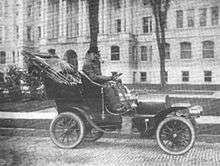Frederick W. Smith (physician)
| Frederick W. Smith | |
|---|---|
| Born |
August 24, 1858 Triangle, Broome County, New York, United States |
| Died | Syracuse, New York |
| Citizenship | United States |
| Alma mater | New York University and Syracuse University |
| Occupation | Physician, Surgeon |
| Known for |
Coroner for Onondaga County, New York Health Commissioner for the city of Syracuse.[1] New York State Board of Health |
Frederick William Smith (August 24, 1858 – after 1913) was a physician and surgeon in Syracuse, New York.[1] By 1897, he was serving as Health Commissioner for the city of Syracuse[2] and during June 1902, he was appointed as health officer of the city.[3] He also served as coroner of Onondaga County, New York.[1]
Biography
Frederick William Smith M.D. was born in Triangle, New York in Broome County on August 24, 1858. He was educated at Lisle Academy and University of the City of New York.[1]
Smith graduated from medical school in 1881 from Syracuse University and that same year was appointed as "demonstrator of anatomy" at his alma mater.[4]

Medical career
By 1897, he was serving a term as Health Commissioner for the city of Syracuse.[2]
In 1900, he was director of the New York Casualty Company and a member of the New York State Board of Health where he served on the Tuberculosis Committee. Smith was also a member of the American Public Health Association and the Syracuse Academy of Medicine.[1]
During June 1902, he was appointed as health officer of the city of Syracuse.[3]
By November 12, 1904, he was "assistant medical inspector" and according to the New York Medical Journal he visited the Department of Health of New York City and the New York City Public Schools to "inspect the methods" of that department.[5]
He was the former coroner of Onondaga County, New York.[1]
Automobile in duties
In December 1905, Smith, health officer of Syracuse, "runs a gasoline runabout" in the discharge of his duties. The machine was owned by the doctor, but he used it "about as much for the city as for himself." In the epidemic of scarlet fever which swept over the city in the spring and summer of 1904, the automobile "played a prominent part." Before the city officials knew it, there were hundreds of cases of the fever in the city and "strenuous efforts were in order to check the spread of the disease." Hundreds of homes were visited by Smith in his automobile and he "may be ascribed much of the progress which the city officials made in stamping out the disease."[6]
Personal life
By 1902, Frederick W. Smith was a member of the Syracuse chapter of the Sons of the American Revolution along with Lyman C. Smith, also originally from Broome County, New York and one of the Smith brothers who founded Smith Premier Typewriter in Syracuse. The president of the society in Syracuse was James M. Belden.[7]
In June 1904, an article in Motor Age magazine titled How to be Popular, noted that automobile tours had become "quite the fad" among public officials "striving for popularity." Mayor Alan S. Fobes of Syracuse rewarded all the city officials with an outing to South Bay, New York during which time, Dr. Frederick W. Smith, health officer, took his subordinates out in automobiles.[8]
He was married on November 12, 1913 to Charlotte R. Williams. The ceremony was performed by Rev. James B. Knappenberger of the Wesleyan Methodist Episcopal Church.[2]
References
- 1 2 3 4 5 6 Biographical directory of the state of New York, 1900. Biographical Directory Company, 1900. Retrieved January 1, 2011.
- 1 2 3 "Pull and Haul! Democratic Politicians Having a Congenial Time Over Health Commissioners". The Syracuse Standard. Syracuse, New York. February 14, 1897.
- 1 2 JAMA: The Journal of the American Medical Association. American Medical Association - June 28, 1902. Retrieved January 2, 2011.
- ↑ The Medical bulletin: a monthly journal of medicine and surgery, Volume 3. The Medical Bulletin Publishing Company - December 1881. Retrieved January 2, 2011.
- ↑ New York medical journal, Volume 80, Issues 14-26. The New York Medical Journal - November 12, 1904. Retrieved January 2, 2011.
- ↑ Pierce-Racine. E. P. Ingersoll, The Horseless Age, 1905, pg.17. Retrieved August 28, 2011.
- ↑ Louis H. Cornish. A national register of the society, Sons of the American Revolution. Sons of the American Revolution - 1902. Retrieved January 2, 2011.
- ↑ Motor age, Volume 5, No. 23. The Trade Press - June 9, 1904. Retrieved January 2, 2011.